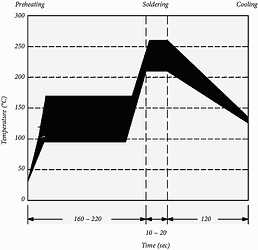
Manufacturers are now producing lead-free components and the sector as a whole is moving very quickly to lead-free electronic devices. Bourns' range of polymer PTC product line meets the requirements of the global community with a product family of lead free surface mount products.
The development of the lead-free devices involved converting the tin lead plating on product terminations to a lead-free alternative. Strict criteria were developed to guide the selection of the optimum material:
1. The lead free termination should have no adverse effect on the ability of the component to solder to an interconnecting substrate.
2. The strength of the bond between the terminal and the substrate must be maintained at the existing high level, significantly above the industry standard (JIS-C-6429).
3. The devices must be compatible with traditional tin lead solders as well as lead free solders.
4. The devices must have the ability to withstand the peak temperature of the standard reflow temperature profile of both types of solder, typically 245°C for tin lead and 260°C for lead-free.
5. The components should be exposed to the industry accepted accelerated steam ageing process (Reference J-STD-002A) to evaluate the long-term durability and reliability of the lead-free terminations.
6. Storage under normal conditions (40°C Max 75% RH Max) should have no adverse effect on the solderability of the device.
7. Whisker growth should be evaluated by an industry accepted accelerated growth test procedure.
8. The components must be qualified to Bourns' internal and independent agency standards (UL, CSA and TÜV).
9. The product must maintain its commercial competitive advantage.
The tin lead terminations of Bourns' 1812 (MF-MSMD) and 1210 (MF-USMD) product families have been replaced with an electroless nickel immersion gold (ENIG) termination that maintains the high performances and quality standards of the existing Multifuse product family. Subsequently, Bourns has released a 2018 (MF-SMDF) and a 1206 (MF-NSMF) product family with ENIG terminations. A second option of a 100% tin termination is also available on the product families referenced here. The terminations of the larger 3425 and 2920 (MF-SM) product families are only available with 100% tin plated terminations.
SM lead-free PTC products
Bourns Multifuse polymer PTC lead-free surface mount components' (MF-SMDF, MF-MSMF, and MF-NSMF) standard metal termination finish is of electroless nickel immersion gold (ENIG). The finish gives the components long shelf life and the precious metal topcoat provides excellent electrical connectivity. The ENIG finished components fully comply with the solderability characteristics defined in the joint industry standard ANSI/J-STD-002 Category 2.
Bourns offers an alternative electroless 100% tin (Sn) termination finish to the standard ENIG finish. This option is available for applications requiring the soldering characteristics of ANSI/J-STD-002, Category 3.
Category 2: Typical coating durability for non-tin and non-tin lead finishes: This category is intended for surfaces finished with other than Sn or Sn/Pb coatings that will be soldered after an extended time from the time of testing. Standard Bourns Multifuse polymer PTC surface mount products have an ENIG coated terminal consistent with this category. These parts were tested and found to comply with the tests and procedures outlined in Category 2.
Category 3: typical coating durability default for tin and tin lead finishes: A category intended for surfaces finished with Sn or Sn/Pb coatings, which will be soldered after an extended storage from the time of testing. The Bourns Multifuse polymer PTC devices with an optional Sn finish fall into this category and all products with the optional Sn finish meet or exceed the requirements of this category.
Lead-free radial PTC products
In the MF-R standard product design, Sn/Pb solder attaches the metal leads to the PTC body. Performance of the part is not affected by the change to a lead-free option. The only change is how the lead is attached to the PTC body.
Heat resistance, reflow and solderability
The new lead-free plated Bourns Multifuse polymer PTCs have the ability to be reflow-soldered with both lead and lead-free solder pastes (eg, Sn/Ag/Cu). Both types of solder paste require the components to withstand reflow temperatures of 245°C and 260°C (See figure).

To evaluate the durability and reliability of any electronic component termination finish, solderability and steam age tests are conducted. Bourns components with the ENIG finish and with the 100% Sn finish underwent extensive solderability testing. All the Bourns Multifuse polymer PTC lead-free surface mount components are compliant with the Joint Industry Standard, J-STD-002A.
In addition to the solderability tests, the components are fully tested to Bourns own internal qualification tests and independent agency tests. The PTC surface mount components with a Sn finish have also been subjected to a tin whisker accelerated growth test procedure. They have been subjected to temperature cycling tests and constant temperature/humidity test procedures and in each case complied with or exceeded the existing industry standards.
Conclusion
Bourns continues to demonstrate its environmental consciousness to the greater community by developing more environmentally-friendly products. Bourns Multifuse polymer PTCs can be assembled with both lead and lead-free solder pastes and reflow profiles. The tests completed ensure the components meet the guidelines for suppliers transitioning to lead-free components.
© Technews Publishing (Pty) Ltd | All Rights Reserved